Victoria University BLO1105: Analyzing Contract Law and ACL Issues
VerifiedAdded on 2023/03/30
|10
|2331
|240
Case Study
AI Summary
This case study analyzes a scenario involving John, a business graduate, and Span and Spic drycleaners, focusing on contract law and consumer rights. It determines whether a valid contract existed between John and Span and Spic and whether it was breached when John's suit was damaged. The analysis covers essential elements of a contract, including offer, acceptance, consideration, intention, and capacity. The study further examines the validity of an exclusion clause under common law, applying tests like the Incorporation Test, Nature of Document Test, and Reasonable Notice Test. Finally, it assesses John's status as a consumer under the Australian Consumer Law (ACL), exploring his rights concerning service quality and remedies for non-compliance, referencing relevant sections of the ACL and case law. Desklib provides a platform for students to access similar solved assignments and past papers.
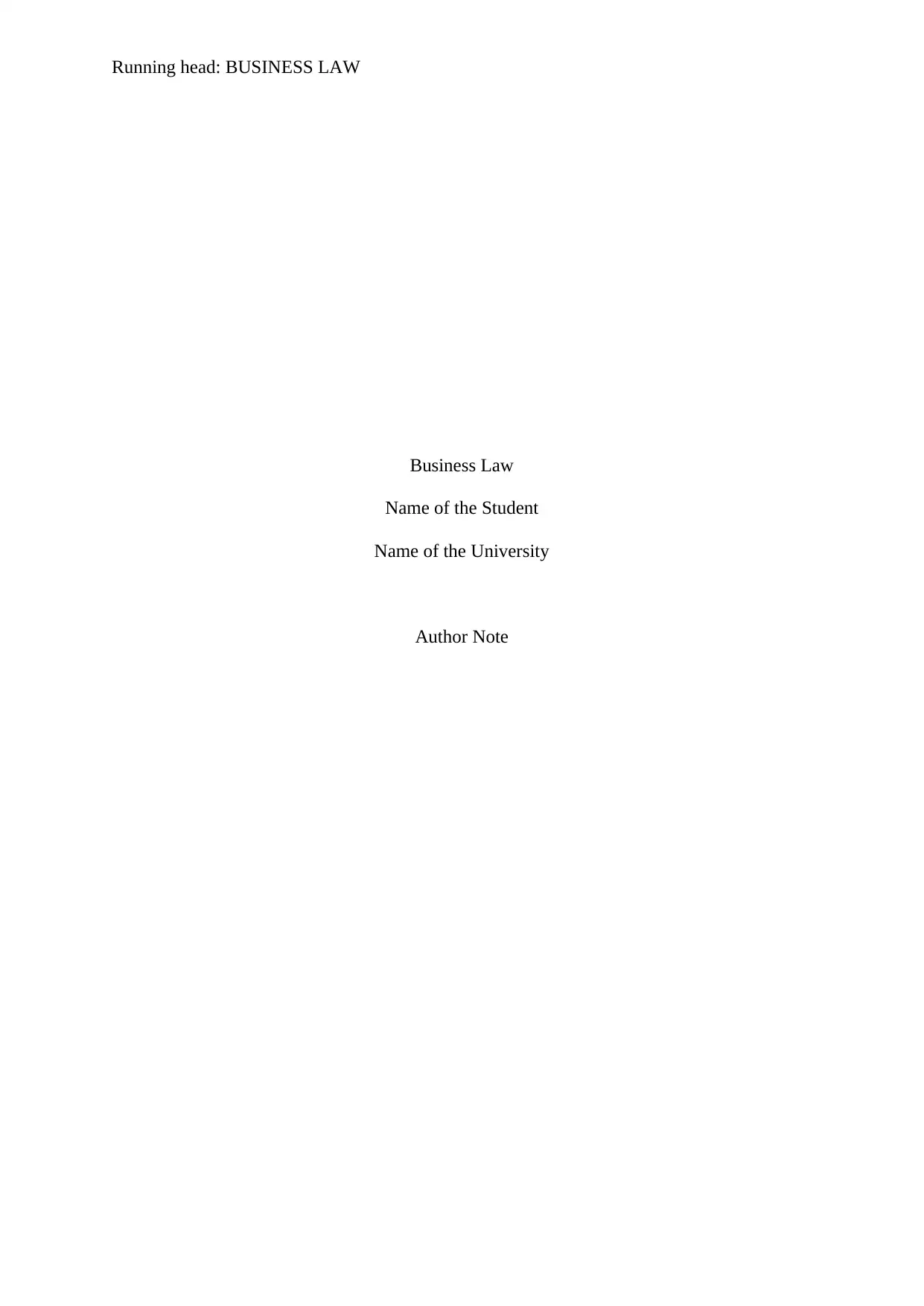
Running head: BUSINESS LAW
Business Law
Name of the Student
Name of the University
Author Note
Business Law
Name of the Student
Name of the University
Author Note
Paraphrase This Document
Need a fresh take? Get an instant paraphrase of this document with our AI Paraphraser
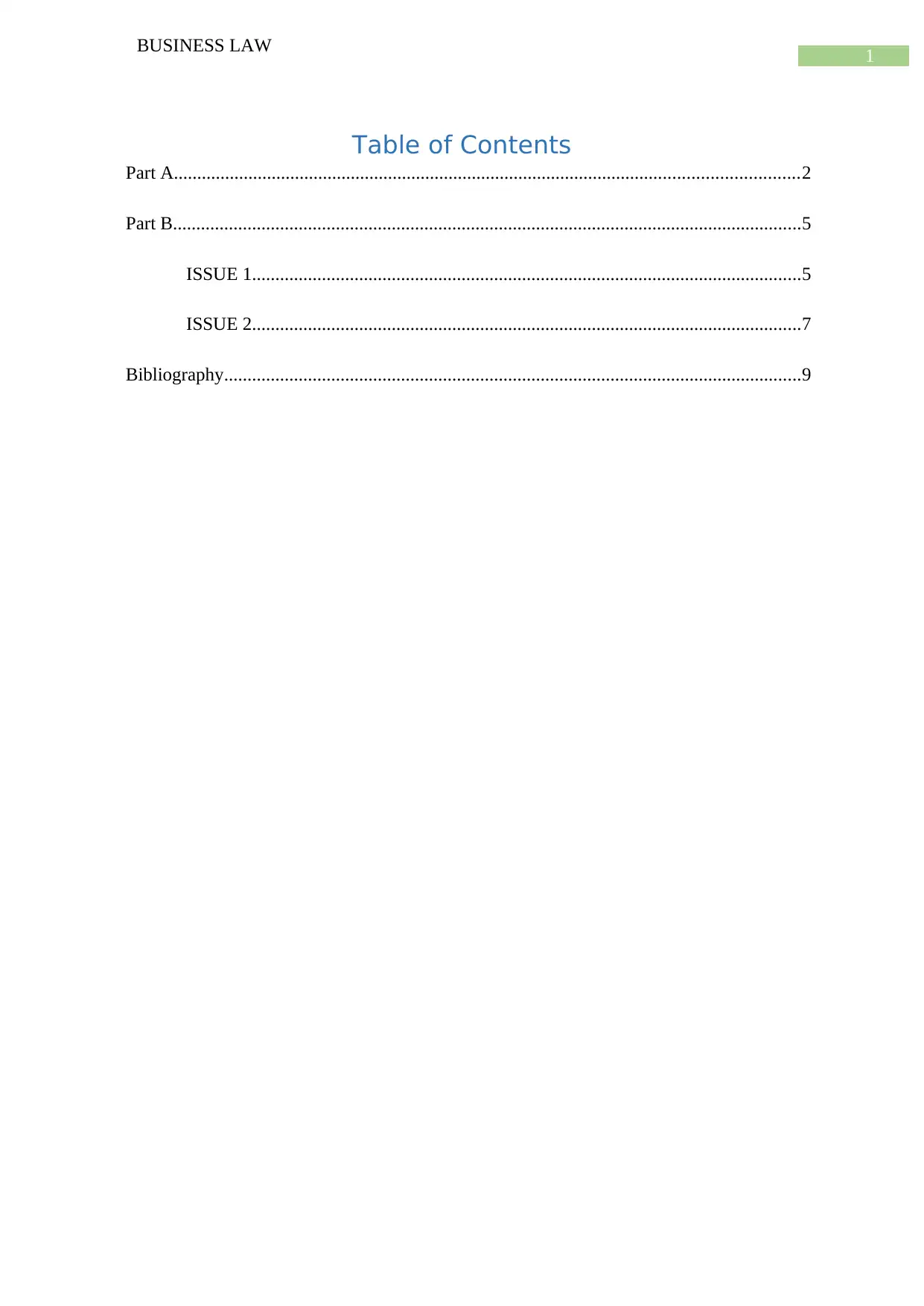
1
BUSINESS LAW
Table of Contents
Part A......................................................................................................................................2
Part B.......................................................................................................................................5
ISSUE 1......................................................................................................................5
ISSUE 2......................................................................................................................7
Bibliography............................................................................................................................9
BUSINESS LAW
Table of Contents
Part A......................................................................................................................................2
Part B.......................................................................................................................................5
ISSUE 1......................................................................................................................5
ISSUE 2......................................................................................................................7
Bibliography............................................................................................................................9

2
BUSINESS LAW
Part A
ISSUE
The issue is to determine whether there is a contract between John and Span and Spic
and whether such contract has been breached.
LAW
A contract refers to an agreement which legally binds the parties to the contract who
agrees to do or not to do something. A valid contract must comply with the following four
essential elements:
1. A valid exchange of Offer and Acceptance,
2. Consideration
3. Intention to be bound to the agreement legally
4. Capacity
A valid exchange of offer and acceptance is essential between the parties to the
contract. The offeror makes an offer to the offeree, who may accept it or may reject it on the
first instance. An acceptance can also be revoked by the offeree before the offeror
acknowledges it. On the other hand, an offer can be revoked by the offeror only before it has
been accepted by the offeree, as once accepted it cannot be revoked by the offeror; either
performance or discharge of the agreement is the only way out1. The offeror must
communicate his offer expressly to the offeree and similarly, the offeree must communicate
back about his acceptance or rejection clearly. An offer is different from an invitation to treat,
as the former directly asks the offeree to consider the terms of the agreement while the latter
invites the offeree to make a counter-offer regarding the object or service of the agreement.
As seen in Pharmaceutical Society of GB v Boots Cash Chemists (Southern) Ltd, an
invitation to treat includes a display of goods which attracts the offeree or buyer to come
1 Parker, David, and Gerald Box. Business Law for Business Students 2008. (Lawbook Company, 2008)
BUSINESS LAW
Part A
ISSUE
The issue is to determine whether there is a contract between John and Span and Spic
and whether such contract has been breached.
LAW
A contract refers to an agreement which legally binds the parties to the contract who
agrees to do or not to do something. A valid contract must comply with the following four
essential elements:
1. A valid exchange of Offer and Acceptance,
2. Consideration
3. Intention to be bound to the agreement legally
4. Capacity
A valid exchange of offer and acceptance is essential between the parties to the
contract. The offeror makes an offer to the offeree, who may accept it or may reject it on the
first instance. An acceptance can also be revoked by the offeree before the offeror
acknowledges it. On the other hand, an offer can be revoked by the offeror only before it has
been accepted by the offeree, as once accepted it cannot be revoked by the offeror; either
performance or discharge of the agreement is the only way out1. The offeror must
communicate his offer expressly to the offeree and similarly, the offeree must communicate
back about his acceptance or rejection clearly. An offer is different from an invitation to treat,
as the former directly asks the offeree to consider the terms of the agreement while the latter
invites the offeree to make a counter-offer regarding the object or service of the agreement.
As seen in Pharmaceutical Society of GB v Boots Cash Chemists (Southern) Ltd, an
invitation to treat includes a display of goods which attracts the offeree or buyer to come
1 Parker, David, and Gerald Box. Business Law for Business Students 2008. (Lawbook Company, 2008)
⊘ This is a preview!⊘
Do you want full access?
Subscribe today to unlock all pages.

Trusted by 1+ million students worldwide

3
BUSINESS LAW
forward and make a counter-offer2. A proper exchange of communication of offer and
acceptance gives a perception that the offeror and the offeree intends to bind each other in the
agreement.
Involvement of a consideration amount is of utmost importance as a legally valid
contract cannot be formed without a consideration, which refers to something that has a value
in the eye of law, for example a mere peppercorn would constitute a valid consideration,
given the fact that it has some value between the offeror and the offeree, as held in
Woolworths Ltd v Kelly3. A consideration must have a value, even if it is not ‘adequate’ as
discussed in Director of Public Prosecutions for Victoria v Le4.
Capacity of the parties refer to the ability of them to enter into a contract that is legally
binding and it involves a party to be an adult (18 years or above), of sound mind, not
intoxicated and not a bankrupt. They should not be barred by the law to enter into a contract
as well. In case the parties or even one of them does not meet the criteria of capacity, the
agreement shall be void ab initio5.
Intention of the parties to create a legal and binding relation is necessary to decide the
fate of the agreement, whether it is to be performed as per the agreed course or if it is to be
discharged. A commercial agreement is mostly presumed to have a clear intention of the
parties as seen in Helmos Enterprises Pty Ltd v Jaylor Pty Ltd, while in case of domestic or
social agreements intention of the parties is always seen to have a legal consequence6.
However it is certain that preliminary agreements that satisfy all the other essential elements
makes the parties eventually bound legally.
An agreement is considered to be breached when one of the parties to the contract have
not followed the agreed terms of the contract, thereby breaking one of the terms or the overall
2 Pharmaceutical Society of GB v Boots Cash Chemists (Southern) Ltd [1956] EWCA 6
3 Woolworths Ltd v Kelly (1991) 22 NSWLR 189
4 Director of Public Prosecutions for Victoria v Le [2007] HCA 52.
5 Parker, David, and Gerald Box. Business Law for Business Students 2008. (Lawbook Company, 2008)
6 Helmos Enterprises Pty Ltd v Jaylor Pty Ltd [2005] NSWCA 235
BUSINESS LAW
forward and make a counter-offer2. A proper exchange of communication of offer and
acceptance gives a perception that the offeror and the offeree intends to bind each other in the
agreement.
Involvement of a consideration amount is of utmost importance as a legally valid
contract cannot be formed without a consideration, which refers to something that has a value
in the eye of law, for example a mere peppercorn would constitute a valid consideration,
given the fact that it has some value between the offeror and the offeree, as held in
Woolworths Ltd v Kelly3. A consideration must have a value, even if it is not ‘adequate’ as
discussed in Director of Public Prosecutions for Victoria v Le4.
Capacity of the parties refer to the ability of them to enter into a contract that is legally
binding and it involves a party to be an adult (18 years or above), of sound mind, not
intoxicated and not a bankrupt. They should not be barred by the law to enter into a contract
as well. In case the parties or even one of them does not meet the criteria of capacity, the
agreement shall be void ab initio5.
Intention of the parties to create a legal and binding relation is necessary to decide the
fate of the agreement, whether it is to be performed as per the agreed course or if it is to be
discharged. A commercial agreement is mostly presumed to have a clear intention of the
parties as seen in Helmos Enterprises Pty Ltd v Jaylor Pty Ltd, while in case of domestic or
social agreements intention of the parties is always seen to have a legal consequence6.
However it is certain that preliminary agreements that satisfy all the other essential elements
makes the parties eventually bound legally.
An agreement is considered to be breached when one of the parties to the contract have
not followed the agreed terms of the contract, thereby breaking one of the terms or the overall
2 Pharmaceutical Society of GB v Boots Cash Chemists (Southern) Ltd [1956] EWCA 6
3 Woolworths Ltd v Kelly (1991) 22 NSWLR 189
4 Director of Public Prosecutions for Victoria v Le [2007] HCA 52.
5 Parker, David, and Gerald Box. Business Law for Business Students 2008. (Lawbook Company, 2008)
6 Helmos Enterprises Pty Ltd v Jaylor Pty Ltd [2005] NSWCA 235
Paraphrase This Document
Need a fresh take? Get an instant paraphrase of this document with our AI Paraphraser
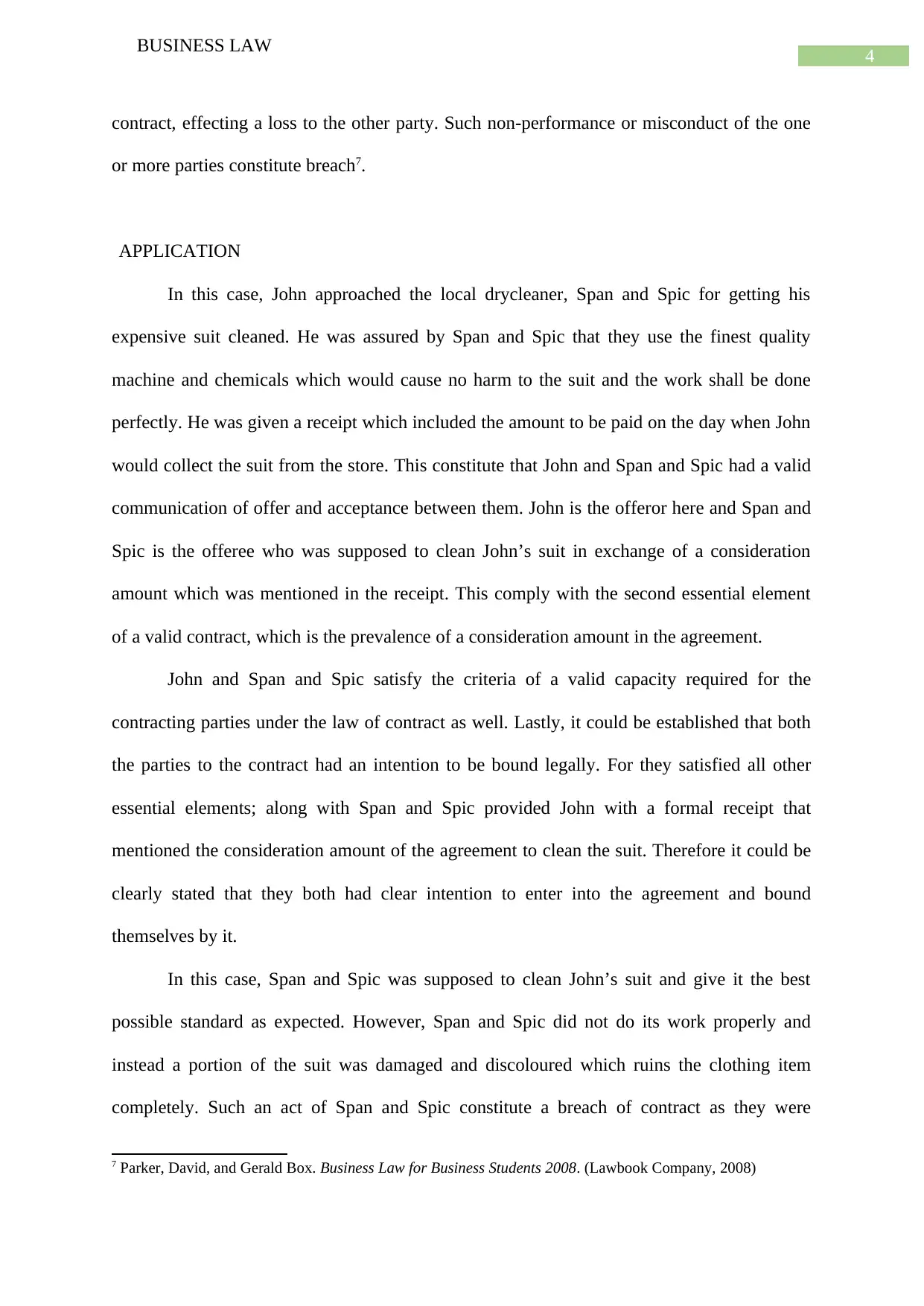
4
BUSINESS LAW
contract, effecting a loss to the other party. Such non-performance or misconduct of the one
or more parties constitute breach7.
APPLICATION
In this case, John approached the local drycleaner, Span and Spic for getting his
expensive suit cleaned. He was assured by Span and Spic that they use the finest quality
machine and chemicals which would cause no harm to the suit and the work shall be done
perfectly. He was given a receipt which included the amount to be paid on the day when John
would collect the suit from the store. This constitute that John and Span and Spic had a valid
communication of offer and acceptance between them. John is the offeror here and Span and
Spic is the offeree who was supposed to clean John’s suit in exchange of a consideration
amount which was mentioned in the receipt. This comply with the second essential element
of a valid contract, which is the prevalence of a consideration amount in the agreement.
John and Span and Spic satisfy the criteria of a valid capacity required for the
contracting parties under the law of contract as well. Lastly, it could be established that both
the parties to the contract had an intention to be bound legally. For they satisfied all other
essential elements; along with Span and Spic provided John with a formal receipt that
mentioned the consideration amount of the agreement to clean the suit. Therefore it could be
clearly stated that they both had clear intention to enter into the agreement and bound
themselves by it.
In this case, Span and Spic was supposed to clean John’s suit and give it the best
possible standard as expected. However, Span and Spic did not do its work properly and
instead a portion of the suit was damaged and discoloured which ruins the clothing item
completely. Such an act of Span and Spic constitute a breach of contract as they were
7 Parker, David, and Gerald Box. Business Law for Business Students 2008. (Lawbook Company, 2008)
BUSINESS LAW
contract, effecting a loss to the other party. Such non-performance or misconduct of the one
or more parties constitute breach7.
APPLICATION
In this case, John approached the local drycleaner, Span and Spic for getting his
expensive suit cleaned. He was assured by Span and Spic that they use the finest quality
machine and chemicals which would cause no harm to the suit and the work shall be done
perfectly. He was given a receipt which included the amount to be paid on the day when John
would collect the suit from the store. This constitute that John and Span and Spic had a valid
communication of offer and acceptance between them. John is the offeror here and Span and
Spic is the offeree who was supposed to clean John’s suit in exchange of a consideration
amount which was mentioned in the receipt. This comply with the second essential element
of a valid contract, which is the prevalence of a consideration amount in the agreement.
John and Span and Spic satisfy the criteria of a valid capacity required for the
contracting parties under the law of contract as well. Lastly, it could be established that both
the parties to the contract had an intention to be bound legally. For they satisfied all other
essential elements; along with Span and Spic provided John with a formal receipt that
mentioned the consideration amount of the agreement to clean the suit. Therefore it could be
clearly stated that they both had clear intention to enter into the agreement and bound
themselves by it.
In this case, Span and Spic was supposed to clean John’s suit and give it the best
possible standard as expected. However, Span and Spic did not do its work properly and
instead a portion of the suit was damaged and discoloured which ruins the clothing item
completely. Such an act of Span and Spic constitute a breach of contract as they were
7 Parker, David, and Gerald Box. Business Law for Business Students 2008. (Lawbook Company, 2008)
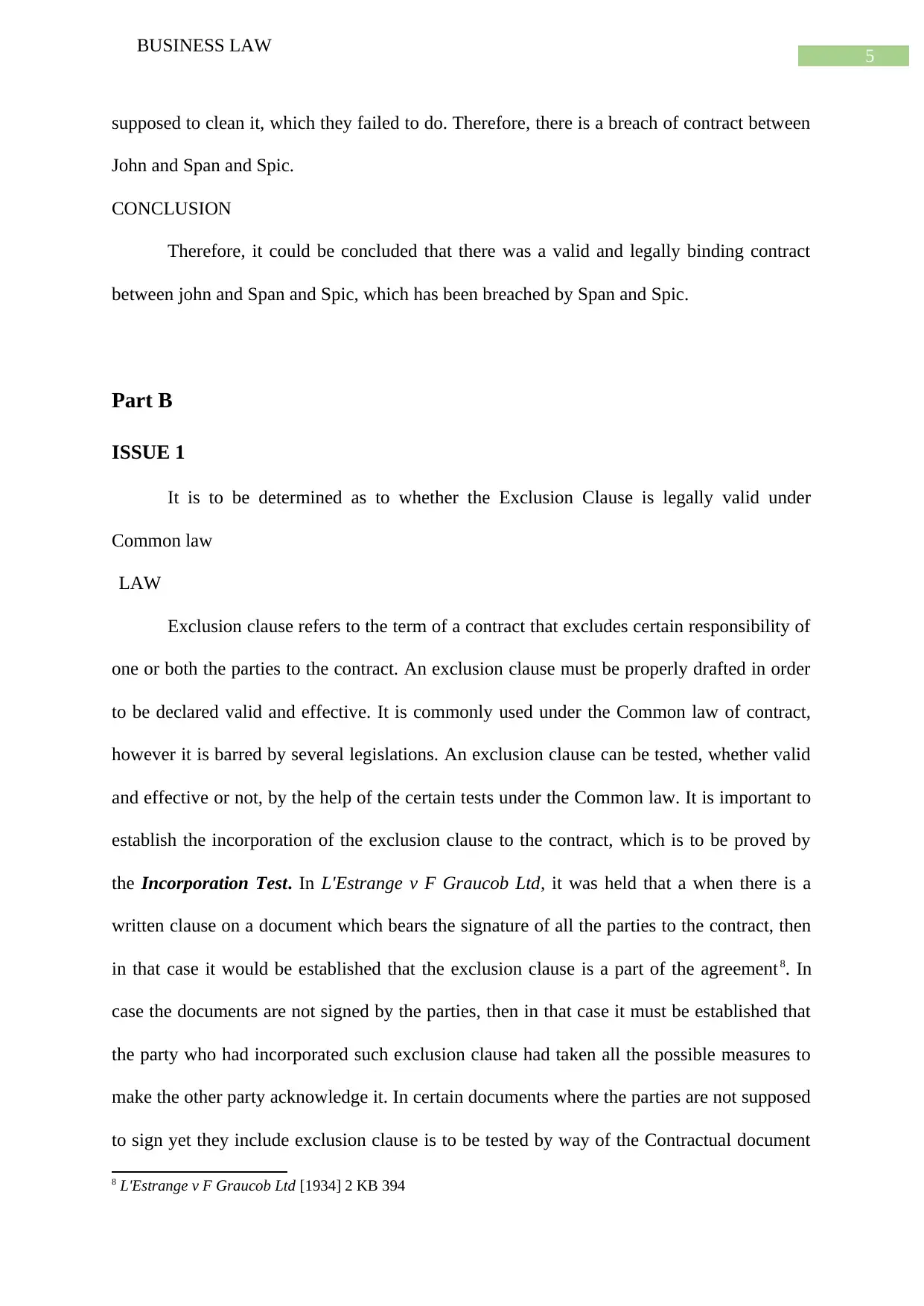
5
BUSINESS LAW
supposed to clean it, which they failed to do. Therefore, there is a breach of contract between
John and Span and Spic.
CONCLUSION
Therefore, it could be concluded that there was a valid and legally binding contract
between john and Span and Spic, which has been breached by Span and Spic.
Part B
ISSUE 1
It is to be determined as to whether the Exclusion Clause is legally valid under
Common law
LAW
Exclusion clause refers to the term of a contract that excludes certain responsibility of
one or both the parties to the contract. An exclusion clause must be properly drafted in order
to be declared valid and effective. It is commonly used under the Common law of contract,
however it is barred by several legislations. An exclusion clause can be tested, whether valid
and effective or not, by the help of the certain tests under the Common law. It is important to
establish the incorporation of the exclusion clause to the contract, which is to be proved by
the Incorporation Test. In L'Estrange v F Graucob Ltd, it was held that a when there is a
written clause on a document which bears the signature of all the parties to the contract, then
in that case it would be established that the exclusion clause is a part of the agreement8. In
case the documents are not signed by the parties, then in that case it must be established that
the party who had incorporated such exclusion clause had taken all the possible measures to
make the other party acknowledge it. In certain documents where the parties are not supposed
to sign yet they include exclusion clause is to be tested by way of the Contractual document
8 L'Estrange v F Graucob Ltd [1934] 2 KB 394
BUSINESS LAW
supposed to clean it, which they failed to do. Therefore, there is a breach of contract between
John and Span and Spic.
CONCLUSION
Therefore, it could be concluded that there was a valid and legally binding contract
between john and Span and Spic, which has been breached by Span and Spic.
Part B
ISSUE 1
It is to be determined as to whether the Exclusion Clause is legally valid under
Common law
LAW
Exclusion clause refers to the term of a contract that excludes certain responsibility of
one or both the parties to the contract. An exclusion clause must be properly drafted in order
to be declared valid and effective. It is commonly used under the Common law of contract,
however it is barred by several legislations. An exclusion clause can be tested, whether valid
and effective or not, by the help of the certain tests under the Common law. It is important to
establish the incorporation of the exclusion clause to the contract, which is to be proved by
the Incorporation Test. In L'Estrange v F Graucob Ltd, it was held that a when there is a
written clause on a document which bears the signature of all the parties to the contract, then
in that case it would be established that the exclusion clause is a part of the agreement8. In
case the documents are not signed by the parties, then in that case it must be established that
the party who had incorporated such exclusion clause had taken all the possible measures to
make the other party acknowledge it. In certain documents where the parties are not supposed
to sign yet they include exclusion clause is to be tested by way of the Contractual document
8 L'Estrange v F Graucob Ltd [1934] 2 KB 394
⊘ This is a preview!⊘
Do you want full access?
Subscribe today to unlock all pages.

Trusted by 1+ million students worldwide
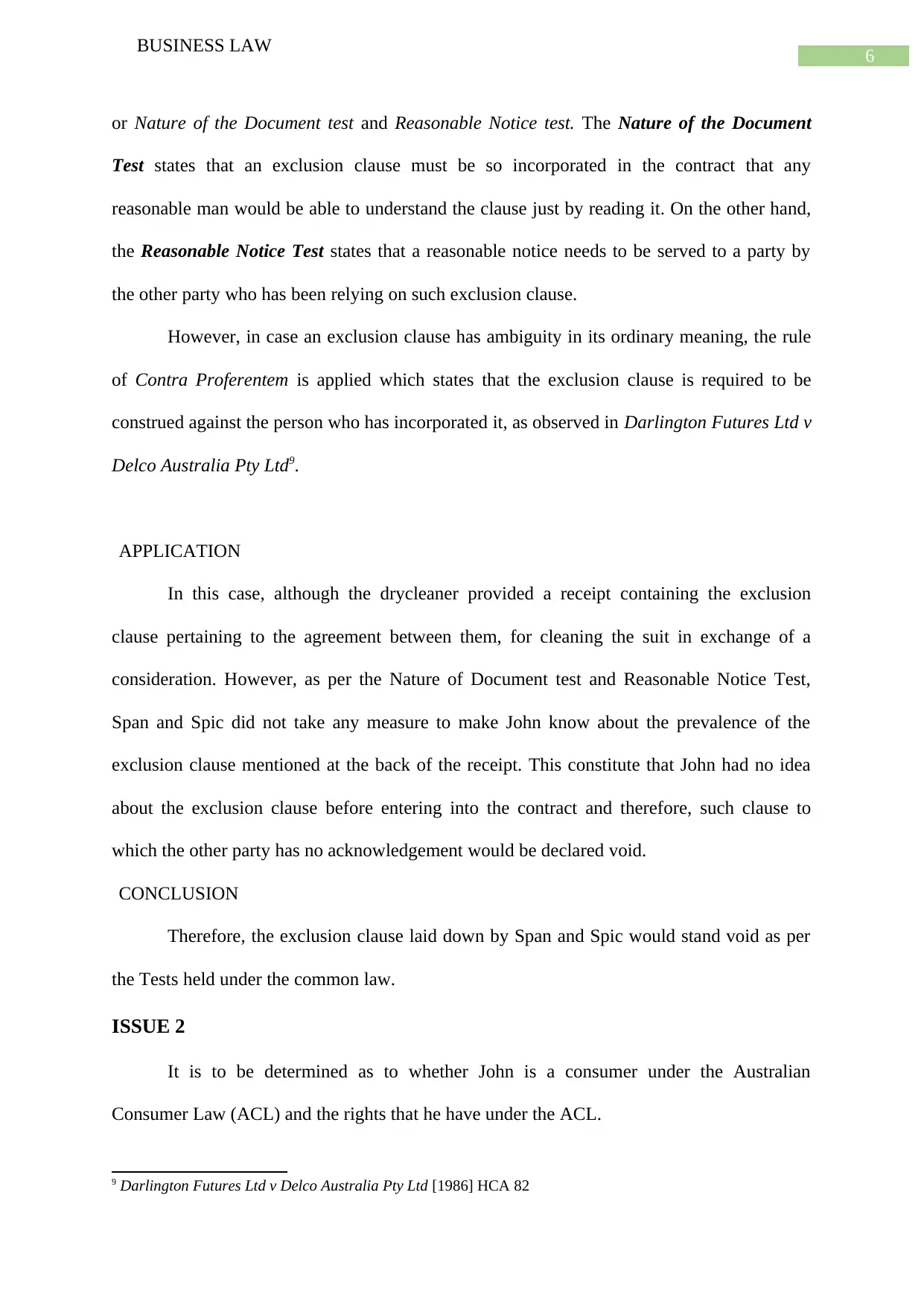
6
BUSINESS LAW
or Nature of the Document test and Reasonable Notice test. The Nature of the Document
Test states that an exclusion clause must be so incorporated in the contract that any
reasonable man would be able to understand the clause just by reading it. On the other hand,
the Reasonable Notice Test states that a reasonable notice needs to be served to a party by
the other party who has been relying on such exclusion clause.
However, in case an exclusion clause has ambiguity in its ordinary meaning, the rule
of Contra Proferentem is applied which states that the exclusion clause is required to be
construed against the person who has incorporated it, as observed in Darlington Futures Ltd v
Delco Australia Pty Ltd9.
APPLICATION
In this case, although the drycleaner provided a receipt containing the exclusion
clause pertaining to the agreement between them, for cleaning the suit in exchange of a
consideration. However, as per the Nature of Document test and Reasonable Notice Test,
Span and Spic did not take any measure to make John know about the prevalence of the
exclusion clause mentioned at the back of the receipt. This constitute that John had no idea
about the exclusion clause before entering into the contract and therefore, such clause to
which the other party has no acknowledgement would be declared void.
CONCLUSION
Therefore, the exclusion clause laid down by Span and Spic would stand void as per
the Tests held under the common law.
ISSUE 2
It is to be determined as to whether John is a consumer under the Australian
Consumer Law (ACL) and the rights that he have under the ACL.
9 Darlington Futures Ltd v Delco Australia Pty Ltd [1986] HCA 82
BUSINESS LAW
or Nature of the Document test and Reasonable Notice test. The Nature of the Document
Test states that an exclusion clause must be so incorporated in the contract that any
reasonable man would be able to understand the clause just by reading it. On the other hand,
the Reasonable Notice Test states that a reasonable notice needs to be served to a party by
the other party who has been relying on such exclusion clause.
However, in case an exclusion clause has ambiguity in its ordinary meaning, the rule
of Contra Proferentem is applied which states that the exclusion clause is required to be
construed against the person who has incorporated it, as observed in Darlington Futures Ltd v
Delco Australia Pty Ltd9.
APPLICATION
In this case, although the drycleaner provided a receipt containing the exclusion
clause pertaining to the agreement between them, for cleaning the suit in exchange of a
consideration. However, as per the Nature of Document test and Reasonable Notice Test,
Span and Spic did not take any measure to make John know about the prevalence of the
exclusion clause mentioned at the back of the receipt. This constitute that John had no idea
about the exclusion clause before entering into the contract and therefore, such clause to
which the other party has no acknowledgement would be declared void.
CONCLUSION
Therefore, the exclusion clause laid down by Span and Spic would stand void as per
the Tests held under the common law.
ISSUE 2
It is to be determined as to whether John is a consumer under the Australian
Consumer Law (ACL) and the rights that he have under the ACL.
9 Darlington Futures Ltd v Delco Australia Pty Ltd [1986] HCA 82
Paraphrase This Document
Need a fresh take? Get an instant paraphrase of this document with our AI Paraphraser

7
BUSINESS LAW
LAW
Section 3 of the ACL states a person who is acquiring certain services from another
worth $40,000 or less and if it exceeds that amount then it is a service for personal or
domestic use10.
Section 60 of the ACL states that a consumer shall receive a service from a service
provider or supplier with due care and skill11. While section 61 states that when a consumer
receives a service for a particular purpose, he must receive such a service which should be
reasonably fit for the purpose12. The consumer may make the service-provider/supplier know
that the service he is looking forward to, must meet a particular nature, quality or condition
for achieving a particular purpose; the service-provider or supplier needs to follow such
requirement in that case as seen in Thornton v Shoe Lane Parking Ltd13.
Section 267 of ACL empowers the consumer to take an action against the supplier if
the service promised by supplier does not comply with the agreed terms. In case of a minor
fault as held in section 267(2), the consumer may ask the supplier to provide a remedy for his
failure to comply with the terms within a reasonable time14. In case of a major fault, the
consumer shall be liable to terminate the contract and recover compensation for the reduced
value of the service received from the supplier. The consumer shall be liable to recover
damages for the losses sustained by him due to the supplier’s failure to comply with the
consumer guarantee which was reasonably foreseeable.
APPLICATION
In this section of the case study, it could be established that John was a consumer as
per the provision of the Australian Consumer Law. He acquired a service for cleaning a suit
10 Australian Consumer Law s 3
11 Australian Consumer Law s 60
12 Australian Consumer Law, s 61
13 Thornton v Shoe Lane Parking Ltd [1970] EWCA Civ 2
14 Australian Consumer Law s 267(2)
BUSINESS LAW
LAW
Section 3 of the ACL states a person who is acquiring certain services from another
worth $40,000 or less and if it exceeds that amount then it is a service for personal or
domestic use10.
Section 60 of the ACL states that a consumer shall receive a service from a service
provider or supplier with due care and skill11. While section 61 states that when a consumer
receives a service for a particular purpose, he must receive such a service which should be
reasonably fit for the purpose12. The consumer may make the service-provider/supplier know
that the service he is looking forward to, must meet a particular nature, quality or condition
for achieving a particular purpose; the service-provider or supplier needs to follow such
requirement in that case as seen in Thornton v Shoe Lane Parking Ltd13.
Section 267 of ACL empowers the consumer to take an action against the supplier if
the service promised by supplier does not comply with the agreed terms. In case of a minor
fault as held in section 267(2), the consumer may ask the supplier to provide a remedy for his
failure to comply with the terms within a reasonable time14. In case of a major fault, the
consumer shall be liable to terminate the contract and recover compensation for the reduced
value of the service received from the supplier. The consumer shall be liable to recover
damages for the losses sustained by him due to the supplier’s failure to comply with the
consumer guarantee which was reasonably foreseeable.
APPLICATION
In this section of the case study, it could be established that John was a consumer as
per the provision of the Australian Consumer Law. He acquired a service for cleaning a suit
10 Australian Consumer Law s 3
11 Australian Consumer Law s 60
12 Australian Consumer Law, s 61
13 Thornton v Shoe Lane Parking Ltd [1970] EWCA Civ 2
14 Australian Consumer Law s 267(2)
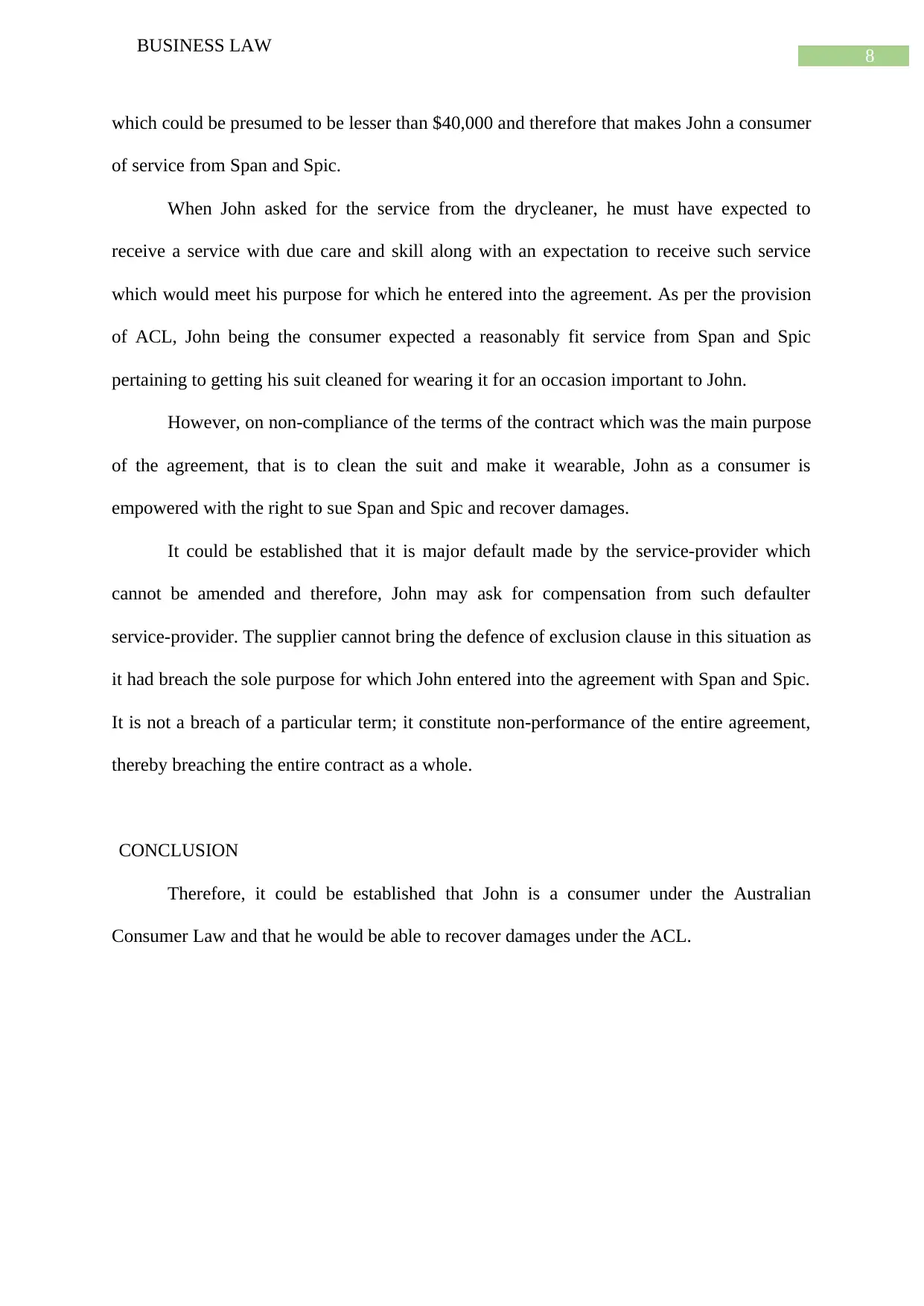
8
BUSINESS LAW
which could be presumed to be lesser than $40,000 and therefore that makes John a consumer
of service from Span and Spic.
When John asked for the service from the drycleaner, he must have expected to
receive a service with due care and skill along with an expectation to receive such service
which would meet his purpose for which he entered into the agreement. As per the provision
of ACL, John being the consumer expected a reasonably fit service from Span and Spic
pertaining to getting his suit cleaned for wearing it for an occasion important to John.
However, on non-compliance of the terms of the contract which was the main purpose
of the agreement, that is to clean the suit and make it wearable, John as a consumer is
empowered with the right to sue Span and Spic and recover damages.
It could be established that it is major default made by the service-provider which
cannot be amended and therefore, John may ask for compensation from such defaulter
service-provider. The supplier cannot bring the defence of exclusion clause in this situation as
it had breach the sole purpose for which John entered into the agreement with Span and Spic.
It is not a breach of a particular term; it constitute non-performance of the entire agreement,
thereby breaching the entire contract as a whole.
CONCLUSION
Therefore, it could be established that John is a consumer under the Australian
Consumer Law and that he would be able to recover damages under the ACL.
BUSINESS LAW
which could be presumed to be lesser than $40,000 and therefore that makes John a consumer
of service from Span and Spic.
When John asked for the service from the drycleaner, he must have expected to
receive a service with due care and skill along with an expectation to receive such service
which would meet his purpose for which he entered into the agreement. As per the provision
of ACL, John being the consumer expected a reasonably fit service from Span and Spic
pertaining to getting his suit cleaned for wearing it for an occasion important to John.
However, on non-compliance of the terms of the contract which was the main purpose
of the agreement, that is to clean the suit and make it wearable, John as a consumer is
empowered with the right to sue Span and Spic and recover damages.
It could be established that it is major default made by the service-provider which
cannot be amended and therefore, John may ask for compensation from such defaulter
service-provider. The supplier cannot bring the defence of exclusion clause in this situation as
it had breach the sole purpose for which John entered into the agreement with Span and Spic.
It is not a breach of a particular term; it constitute non-performance of the entire agreement,
thereby breaching the entire contract as a whole.
CONCLUSION
Therefore, it could be established that John is a consumer under the Australian
Consumer Law and that he would be able to recover damages under the ACL.
⊘ This is a preview!⊘
Do you want full access?
Subscribe today to unlock all pages.

Trusted by 1+ million students worldwide

9
BUSINESS LAW
Bibliography
Books
Parker, David, and Gerald Box. Business Law for Business Students 2008. (Lawbook
Company, 2008)
Case law
Pharmaceutical Society of GB v Boots Cash Chemists (Southern) Ltd [1956] EWCA 6
Woolworths Ltd v Kelly (1991) 22 NSWLR 189
Director of Public Prosecutions for Victoria v Le [2007] HCA 52
Helmos Enterprises Pty Ltd v Jaylor Pty Ltd [2005] NSWCA 235
L'Estrange v F Graucob Ltd [1934] 2 KB 394
Darlington Futures Ltd v Delco Australia Pty Ltd [1986] HCA 82
Thornton v Shoe Lane Parking Ltd [1970] EWCA Civ 2
Legislation
Australian Consumer Law
BUSINESS LAW
Bibliography
Books
Parker, David, and Gerald Box. Business Law for Business Students 2008. (Lawbook
Company, 2008)
Case law
Pharmaceutical Society of GB v Boots Cash Chemists (Southern) Ltd [1956] EWCA 6
Woolworths Ltd v Kelly (1991) 22 NSWLR 189
Director of Public Prosecutions for Victoria v Le [2007] HCA 52
Helmos Enterprises Pty Ltd v Jaylor Pty Ltd [2005] NSWCA 235
L'Estrange v F Graucob Ltd [1934] 2 KB 394
Darlington Futures Ltd v Delco Australia Pty Ltd [1986] HCA 82
Thornton v Shoe Lane Parking Ltd [1970] EWCA Civ 2
Legislation
Australian Consumer Law
1 out of 10
Related Documents
Your All-in-One AI-Powered Toolkit for Academic Success.
+13062052269
info@desklib.com
Available 24*7 on WhatsApp / Email
![[object Object]](/_next/static/media/star-bottom.7253800d.svg)
Unlock your academic potential
Copyright © 2020–2025 A2Z Services. All Rights Reserved. Developed and managed by ZUCOL.





